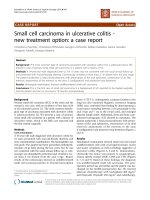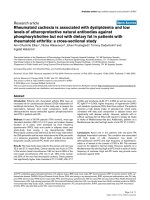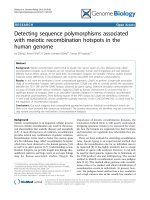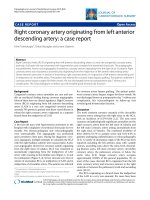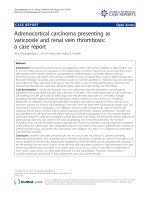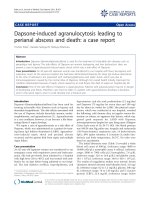Báo cáo y học: "Papillary thyroid cancer associated with syndrome of inappropriate antidiuresis: a case report" doc
Bạn đang xem bản rút gọn của tài liệu. Xem và tải ngay bản đầy đủ của tài liệu tại đây (779.17 KB, 4 trang )
JOURNAL OF MEDICAL
CASE REPORTS
Beier et al. Journal of Medical Case Reports 2010, 4:110
/>Open Access
CASE REPORT
BioMed Central
© 2010 Beier et al; licensee BioMed Central Ltd. This is an Open Access article distributed under the terms of the Creative Commons
Attribution License ( which permits unrestricted use, distribution, and reproduction in
any medium, provided the original work is properly cited.
Case report
Papillary thyroid cancer associated with syndrome
of inappropriate antidiuresis: a case report
Fabian Beier*
1
, Lukas Moleda
2
, Viktoria Guralnik
2
, Philipp Hahn
2
, Katharina Schardt
3
, Reinhard Andreesen
1
,
Jürgen Schölmerich
2
and Andreas Schäffler
2
Abstract
Introduction: The syndrome of inappropriate antidiuresis is the most common cause of euvolemic hypo-osmolality.
This syndrome is associated with a wide variety of diseases. However, its most frequent causes are related to
malignancies, especially lung cancer. In this case report, we describe an unknown association of the syndrome of
inappropriate antidiuresis with papillary thyroid cancer.
Case presentation: We present the case of a 71-year-old Caucasian, German woman with marked hyponatremia and
neurological symptoms. After a detailed clinical investigation, the common causes of syndrome of inappropriate
antidiuresis and other malignancies were ruled out. A thyroid nodule was detected by ultrasound and magnetic
resonance imaging. Although fine needle aspiration cytology showed negative results, our patient underwent surgery.
Papillary thyroid cancer was later diagnosed. After total thyroidectomy, a complete remission of the clinical symptoms
occurred and our patient subsequently had iodine-131 radioactive therapy. Hyponatremia was no longer observed
during the follow-up investigations.
Conclusion: This is the first reported case of paraneoplastic syndrome of inappropriate antidiuresis caused by papillary
thyroid carcinoma. Since its symptoms occurred before the development of local symptoms, total thyroidectomy may
provide a timely and efficient treatment for the underlying malignancy.
Introduction
The first clinical description of a patient with syndrome
of inappropriate antidiuresis (SIAD) was published by
Schwartz et al. in 1957 [1]. Two patients with lung cancer
presenting with hyponatremia and continual loss of uri-
nary sodium were described. The authors concluded that
the syndrome is caused by inappropriate release of the
antidiuretic hormone (ADH). Their hypothesis was later
confirmed in several studies [2].
The main clinical findings of SIAD are as follows: (i)
hyponatremia with decreased effective serum osmolality
(<275 mmol/kg), (ii) clinical euvolemia, (iii) urine osmo-
lality (>100 mmol/kg) above the respective serum osmo-
lality, (iv) a high rate of renal sodium excretion (>40
mmol/L), and (v) normal thyroid and adrenal functions
and absence of diuretic agents (Table 1) [3]. The syn-
drome may be triggered by conditions such as malignant
tumors, drugs, pulmonary diseases or central nervous
system disorders. The vast majority of patients whose
SIAD is caused by malignant disease have bronchogenic
carcinoma as the underlying cause. Furthermore, malig-
nancies of the urinary and gastrointestinal tracts, brain
tumors, lymphomas, sarcomas, thymomas, oropharynx,
and gynecological tumors are typically associated with
SIAD [4].
Papillary thyroid cancer is the most common subtype
of thyroid cancer. The prognosis of patients with papillary
thyroid cancer is very good (10-year overall survival in
more than 80% of cases) [5]. So far, only a few cases of
thyroid cancer have been described in relation to hypona-
tremia [6]. However, research on the association of papil-
lary thyroid cancer with SIAD has yet to be published.
In this report, we describe a patient with papillary thy-
roid cancer associated with neurological symptoms
resulting from marked hyponatremia due to SIAD. The
complete disappearance of her symptoms after total thy-
roidectomy confirmed the diagnosis of paraneoplastic
SIAD related to papillary thyroid cancer.
* Correspondence:
1
Division of Hematology and Oncology, University Hospital Regensburg,
Franz-Josef-Strauß-Allee 11, 93042 Regensburg, Germany
Full list of author information is available at the end of the article
Beier et al. Journal of Medical Case Reports 2010, 4:110
/>Page 2 of 4
Case presentation
In May 2008, a 71-year-old Caucasian, German woman
was referred to our hospital presenting with weakness,
somnolence, confusion and slurred speech. As reported
by her family, her symptoms had slowly deteriorated
within the previous three months. On physical examina-
tion, our patient had no edema and no evidence of dehy-
dration or hyperhydration. Her initial laboratory
evaluation, however, showed severe hyponatremia (107
mmol/L), low serum osmolality (227 mmol/kg), high
urine sodium (86 mmol/L), and urine osmolality ranging
above the normal serum osmolality (495 mmol/kg) (Table
1). Her renal function was normal (creatinine = 0.48 mg/
dL). Although unnecessary for the diagnosis, her ADH
level was measured in the serum and found to be inap-
propriately high in relation to the respective serum osmo-
lality. Cerebral MRI revealed no abnormalities,
suggesting that hyponatremia had caused her neurologi-
cal symptoms. As thyroid parameters and adrenal func-
tion tests were normal, endocrine dysfunction could be
excluded.
Our patient's medical history revealed intermittent
atrial fibrillation and hypertension for which she had
been treated with metoprolol and ramipril for more than
three years. A drug-induced SIAD was considered as very
unlikely due to her long history of taking metoprolol and
ramipril. The medication was maintained during her
diagnosis and treatment. Her SIAD did not reappear after
thyroidectomy. Neither the parameters investigated nor
the medication given provided an alternative explanation
for the presence of hyponatremia, thus establishing a
diagnosis of SIAD.
Our patient was treated with a fluid restriction of 1.0 to
1.5 liters daily, which led to a continuous increase in her
serum sodium levels. This was paralleled by her
improved neurological status. A computed tomography
(CT) scan of her chest and abdomen failed to detect a
tumor mass, while both upper and lower gastrointestinal
tract endoscopy yielded negative results. Gynecological
investigation also produced no pathological findings. A
thyroid nodule of her right lobe was diagnosed by ultra-
sonography and MRI of her neck (Figure 1). Although the
nodule indicated the suspicion of thyroid cancer, a fine
needle biopsy did not show malignant cells.
Since the diagnosis of SIAD suggested the presence of
an occult tumor, our patient was referred to the surgery
department and underwent total thyroidectomy without
lymph node dissection. Her histological examination
revealed a 1.5 cm sized differentiated papillary thyroid
cancer (pT1 N0 M0) (complete resection with no micro-
scopic residual tumor - RO) (Figure 2). A few days after
surgery, she showed stable serum sodium levels without
fluid restriction and a complete disappearance of neuro-
logical symptoms. Seven weeks after thyroidectomy, she
underwent radioactive therapy with 5154MBq iodine-131
(I-131) and out-patient control of her serum sodium.
Subsequent osmolality did not show any evidence of
SIAD relapse.
Discussion
Paraneoplastic SIAD has been described in relation to a
wide variety of malignant tumors. The syndrome has a
prevalence of up to 15% in patients diagnosed with lung
cancer, especially small-cell lung cancer [4]. Furthermore,
SIAD is present in 3% of patients with head and neck
tumors. A detailed analysis of the available literature
revealed no association between thyroid cancers and
SIAD [7]. In a larger prospective study investigating head
Table 1: Overview of the syndrome of inappropriate antidiuresis criteria and our patient's laboratory findings
SIAD criteria Patient parameter Reference values
Serum: Sodium <135 mmol/L 107 mmol/L 135-150 mmol/L
Serum: Osmolality <275 mOsm/kg 227 mmol/kg 280-296 mmol/kg
Urine: Sodium >40 mmol/L 86 mmol/L 170-250 mmol/L
Urine: Osmolality >100 mOsm/kg 495 mmol/kg 50-1200 mmol/kg
Serum: ADH (only optional) 6.15 pg/mL* <6.70 pg/mL
ADH: antidiuretic hormone.
*Inappropriately high in relation to serum osmolality.
Figure 1 MRI scan of the neck. (A) T2 blade sequence. (B) T2 blade se-
quence with contrast enhancement. The thyroid nodule of the right
lobe is indicated by a white arrow. (Images were provided by the Insti-
tute of Radiology, University of Regensburg).
ABA B
Beier et al. Journal of Medical Case Reports 2010, 4:110
/>Page 3 of 4
and neck tumors, no evidence of the syndrome was
observed before and after neck dissection in patients with
thyroid cancer [8].
While rare, paraneoplastic syndromes, especially ecto-
pic adrenocorticotropic hormone (ACTH) synthesis,
have been described as being related to medullary thyroid
cancer, and fewer associations have been reported in
cases of papillary thyroid cancer [9]. To the best of our
knowledge, cases of paraneoplastic syndromes are sparse
in patients suffering from papillary thyroid cancer, such
as polymyalgia rheumatica, hypercalcemia, dermatopoly-
myositis, paraneoplastic neutrophilia, and neurological
paraneoplastic syndromes such as myoclonus, optic neu-
ritis and Isaac's Syndrome [10-17].
Symptomatic hyponatremia was reported in five
patients with metastatic papillary or follicular thyroid
cancer in relation to a low-iodine diet and levothyroxine
withdrawal prior to I-131 treatment [6]. All these patients
presented with hyponatremia and hypothyroidism. Four
of the five patients underwent total thyroidectomy and all
developed hyponatremia between surgery and the initia-
tion of I-131 radioactive therapy. Based on this, endo-
crine dysfunction has to be ruled out before making a
diagnosis of SIAD [3].
Surgery (total thyroidectomy) and subsequent radioac-
tive therapy are standard procedures for the treatment
and management of patients with papillary thyroid can-
cer. The surgical treatment is based on thyroidectomy
and the excision of locoregional lymph node metastases.
I-131 radioactive therapy is usually administered four to
12 weeks after surgery and its purpose is to destroy any
remnant of thyroid tissue. Differentiated thyroid cancers,
such as papillary thyroid cancer, respond to the stimula-
tion of the thyroid-stimulating hormone (TSH). Based on
this, the suppression of TSH levels using supraphysiologi-
cal doses of levothyroxine is recommended in order to
decrease the rate of recurrence. A further part of the
long-term management is the control of thyroglobulin
levels as a possible marker of recurrence or residual dis-
ease [5]. Our patient received the standard treatment
according to the official guidelines for total thyroidec-
tomy and post-operative I-131 radioactive therapies.
There are several treatment options for SIAD. Slight
hyponatremia can be treated by fluid restriction and by
monitoring the sodium levels of patients. In addition, low
doses of loop diuretics can be administered in order to
increase their serum sodium level. If a patient is suffering
from acute neurological symptoms, a hypertonic saline
infusion (3% sodium chloride [NaCl]) might be necessary
to correct the sodium levels. It is essential to ensure a
very slow rise in sodium levels in order to avoid cerebral
damage, such as pontine myelinolysis, which can be
caused by fast changes. In this context, a so-called "lim-
ited and controlled" therapy has been suggested (elevat-
ing sodium levels of 0.5 to 1 mmol/L/h to a maximum of
120 mmol/L and not to normal ranges).
Currently, there are no official guidelines for the treat-
ment of SIAD. Every physician has to evaluate the best
therapy for treating hyponatremia [3]. In our case, fluid
restriction was sufficient to improve our patient's sodium
levels.
Conclusion
The complete disappearance of our patient's symptoms
after total thyroidectomy confirmed the diagnosis of
paraneoplastic SIAD related to papillary thyroid cancer.
This is the first reported case of paraneoplastic SIAD
caused by papillary thyroid carcinoma. As SIAD symp-
toms appeared before the development of local symp-
toms, papillary thyroid cancer has to be added to the list
of tumors associated with SIAD. This knowledge may
lead to a timely and efficient treatment for this underlying
malignancy.
Consent
Written informed consent was obtained from the patient
for publication of this case report and any accompanying
images. A copy of the written consent is available for
review by the Editor-in-Chief of this journal.
Competing interests
The authors declare that they have no competing interests.
Authors' contributions
FB wrote the manuscript and was involved in the diagnosis and treatment of
our patient. LM, VG and PH were involved in the diagnosis and treatment of
our patient. RA critically reviewed the manuscript. JS was involved in the diag-
nosis and treatment of our patient and critically reviewed the manuscript. AS
acted as the supervising attending physician of our patient and contributed
significantly to the completion of the manuscript. All authors read and
approved the final manuscript.
Acknowledgements
We would like to thank Christoph P Beier for the critical review of the manu-
script. Furthermore, we thank the Institute of Radiology of the University of
Regensburg for providing the magnetic resonance images of our patient.
Author Details
1
Division of Hematology and Oncology, University Hospital Regensburg, Franz-
Josef-Strauß-Allee 11, 93042 Regensburg, Germany,
2
Department of Internal
Medicine I, University Hospital Regensburg, Franz-Josef-Strauß-Allee 11, 93042
Regensburg, Germany and
3
Institute of Pathology, University Hospital
Regensburg, Franz-Josef-Strauß-Allee 11, 93042 Regensburg, Germany
Figure 2 Histological slides of the resected differentiated papil-
lary thyroid cancer. (A) Papillary thyroid cancer. (B) Papillary thyroid
cancer, high magnification, illustrating the papillary structures.
A B
Beier et al. Journal of Medical Case Reports 2010, 4:110
/>Page 4 of 4
References
1. Schwartz WB, Bennett W, Curelop S, Bartter FC: A syndrome of renal
sodium loss and hyponatremia probably resulting from inappropriate
secretion of antidiuretic hormone. Am J Med 1957, 23:529-542.
2. Amatruda TT Jr, Mulrow PJ, Gallagher JC, Sawyer WH: Carcinoma of the
lung with inappropriate antidiuresis: demonstration of antidiuretic
hormone-like activity in tumor extract. N Engl J Med 1963, 269:544-549.
3. Ellison DH, Berl T: Clinical practice: the syndrome of inappropriate
antidiuresis. N Engl J Med 2007, 356:2064-2072.
4. Sorensen JB, Andersen MK, Hansen HH: Syndrome of inappropriate
secretion of antidiuretic hormone (SIADH) in malignant disease. J
Intern Med 1995, 238:97-110.
5. Cooper DS, Doherty GM, Haugen BR, Kloos RT, Lee SL, Mandel SJ,
Mazzaferri EL, McIver B, Sherman SI, Tuttle RM: Management guidelines
for patients with thyroid nodules and differentiated thyroid cancer.
Thyroid 2006, 16:109-142.
6. Shakir MK, Krook LS, Schraml FV, Hays JH, Clyde PW: Symptomatic
hyponatremia in association with a low-iodine diet and levothyroxine
withdrawal prior to I131 in patients with metastatic thyroid carcinoma.
Thyroid 2008, 18:787-792.
7. Ferlito A, Rinaldo A, Devaney KO: Syndrome of inappropriate antidiuretic
hormone secretion associated with head neck cancers: review of the
literature. Ann Otol Rhinol Laryngol 1997, 106:878-883.
8. Zacay G, Bedrin L, Horowitz Z, Peleg M, Yahalom R, Kronenberg J, Taicher
S, Talmi YP: Syndrome of inappropriate antidiuretic hormone or
arginine vasopressin secretion in patients following neck dissection.
Laryngoscope 2002, 112:2020-2024.
9. Barbosa SL, Rodien P, Leboulleux S, Niccoli-Sire P, Kraimps JL, Caron P,
Archambeaud-Mouveroux F, Conte-Devolx B, Rohmer V: Ectopic
adrenocorticotropic hormone-syndrome in medullary carcinoma of
the thyroid: a retrospective analysis and review of the literature.
Thyroid 2005, 15:618-623.
10. Tabata M, Kobayashi T: Polymyalgia rheumatica and thyroid papillary
carcinoma. Intern Med 1994, 33:41-44.
11. Attarian H, Applebee G, von Lepel A: Paraneoplastic myoclonus with
papillary thyroid carcinoma. Eur Neurol 2007, 58:182-183.
12. Vassilatou E, Fisfis M, Morphopoulos G, Savva S, Voucouti E, Stefanoudaki
K, Tzavara I: Papillary thyroid carcinoma producing granulocyte-
macrophage colony-stimulating factor is associated with neutrophilia
and eosinophilia. Hormones (Athens) 2006, 5:303-309.
13. Iguchi H, Miyagi C, Tomita K, Kawauchi S, Nozuka Y, Tsuneyoshi M,
Wakasugi H: Hypercalcemia caused by ectopic production of
parathyroid hormone in a patient with papillary adenocarcinoma of
the thyroid gland. J Clin Endocrinol Metab 1998, 83:2653-2657.
14. Vernino S, Adamski J, Kryzer TJ, Fealey RD, Lennon VA: Neuronal nicotinic
ACh receptor antibody in subacute autonomic neuropathy and cancer-
related syndromes. Neurol 1998, 50:1806-1813.
15. Cross SA, Salomao DR, Parisi JE, Kryzer TJ, Bradley EA, Mines JA, Lam BL,
Lennon VA: Paraneoplastic autoimmune optic neuritis with retinitis
defined by CRMP-5-IgG. Ann Neurol 2003, 54:38-50.
16. Lee JH, Kim SI: A case of dermatomyositis associated with papillary
cancer of the thyroid gland. Clin Rheumatol 2005, 24:437-438.
17. Kalliabakos D, Pappas A, Lagoudianakis E, Papadima A, Chrysikos J,
Basagiannis C, Tsakoumagou M, Skanelli Y, Manouras A: A case of
polymyositis associated with papillary thyroid cancer: a case report.
Cases J 2008, 1:289.
doi: 10.1186/1752-1947-4-110
Cite this article as: Beier et al., Papillary thyroid cancer associated with syn-
drome of inappropriate antidiuresis: a case report Journal of Medical Case
Reports 2010, 4:110
Received: 23 October 2009 Accepted: 21 April 2010
Published: 21 April 2010
This article is available from: 2010 Beier et al; licensee BioMed Central Ltd. This is an Open Access article distributed under the terms of the Creative Commons Attribution License ( ), which permits unrestricted use, distribution, and reproduction in any medium, provided the original work is properly cited.Journal of Medical Case Reports 2010, 4:110
